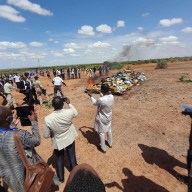SAO PAULO, Brazil – An Air France jet carrying 228 people from Rio de Janeiro to Paris ran into a towering wall of thunderstorms and disappeared over the Atlantic Ocean. French President Nicolas Sarkozy told families of those aboard Monday that “prospects of finding survivors are very small.”
Air France has confirmed that one Canadian citizen was on board the plane.
Radio station CJOY in Guelph, Ont., identified him as Brad Clemes, 49, a Coca-Cola executive who was born and raised in Guelph and lived in France.
A statement released Monday afternoon by the Department of Foreign Affairs said consular officials have been in contact with the missing Canadians family to offer assistance and support. It offered no further details, citing the Privacy Act.
“Our thoughts are with the family,” the statement said.
The area where the plane could have gone down is vast, in the middle of very deep Atlantic Ocean waters between Brazil and the coast of Africa. Brazil’s military searched for it off its northeast coast, while the French military scoured the ocean near the Cape Verde Islands off the West African coast.
If all 228 were killed, it would be the world’s deadliest commercial airline disaster since 2001.
Sarkozy, speaking at Paris’ Charles de Gaulle airport, said the cause is unclear and that “no hypothesis” is being excluded. He called it “a catastrophe like Air France has never before known.”
“(I met with) a mother who lost her son, a fiancee who lost her future husband. I told them the truth,” he said.
Sarkozy said “it will be very difficult” to find the plane because the zone where it is believed to have disappeared “is immense.” He said France has asked for U.S. satellite help to locate the plane.
Chief Air France spokesman Francois Brousse said “it is possible” the plane was hit by lightning, but aviation experts expressed doubt that a bolt of lightning was enough to bring the plane down.
Air France Flight 447, a four-year-old Airbus A330, left Rio Sunday night with 216 passengers and 12 crew members on board, said company spokeswoman Brigitte Barrand.
The plane indicated it was still flying normally more than three hours later as it left Brazil radar contact, beyond the Fernando de Noronha archipelago, at 10:48 local time (9:48 p.m. EDT). It was flying at 10,670 metres and travelling at 840 km/h.
About a half-hour later, the plane “crossed through a thunderous zone with strong turbulence.” It sent an automatic message fourteen minutes later, reporting electrical failure and a loss of cabin pressure.
Air France told Brazilian authorities the last information they heard was that automated message, reporting a technical problem before the plane reached a monitoring station near the Cape Verde islands. Brazilian, African, Spanish and French air traffic controllers tried in vain to establish contact with the plane, the company said.
Brazilian Air Force spokesman Col. Jorge Amaral said seven aircraft had been deployed to search the area far off the northeastern Brazilian coast. Brazil’s navy sent three ships.
“We want to try to reach the last point where the aircraft made contact, which is about 745 miles (1,200 kilometres) northeast of Natal,” Amaral told Globo TV.
Meteorologists said tropical storms are much more violent than thunderstorms in the United States and elsewhere.
“Tropical thunderstorms … can tower up to 50,000 feet (15,240 metres). At the altitude it was flying, it’s possible that the Air France plane flew directly into the most charged part of the storm – the top,” Henry Margusity, senior meteorologist for AccuWeather.com, said in a statement.
Portuguese air control authorities say the missing plane did not make contact with controllers in Portugal’s mid-Atlantic Azores Islands nor, as far as they know, with other Atlantic air traffic controllers in Cape Verde, Casablanca, or the Canary islands.
In Washington, a Pentagon official said he’d seen no indication that terrorism or foul play was involved. He spoke on condition of anonymity due to the sensitive nature of the subject.
The 216 passengers included 126 men, 82 women, seven children and a baby, Air France said. There were 61 French and 58 Brazilians; 30 other countries were represented, including two Americans and the one Canadian.
In Brazil, sobbing relatives were flown to Rio de Janeiro, where Air France was assisting the families. Andres Fernandes, his eyes tearing up, said a relative “was supposed to be on the flight, but we need to confirm it,” Globo TV reported.
At the Charles de Gaulle airport north of Paris, family members declined to speak to reporters and were brought to a cordoned-off crisis centre.
Air France said it expressed “its sincere condolences to the families and loved ones of the passengers and crew members” aboard Flight 447. The airline did not explicitly say there were no survivors, leaving that subject to Sarkozy.
Air France-KLM CEO Pierre-Henri Gourgeon said the pilot had 11,000 hours of flying experience, including 1,700 hours flying this aircraft.
Experts said the absence of a mayday call meant something happened very quickly.
“The conclusion to be drawn is that something catastrophic happened on board that has caused this airplane to ditch in a controlled or an uncontrolled fashion,” Jane’s Aviation analyst Chris Yates told The Associated Press. “Potentially it went down very quickly and so quickly that the pilot on board didn’t have a chance to make that emergency call.”
But aviation experts said the risk the plane was brought down by lightning was slim.
“Lightning issues have been considered since the beginning of aviation. They were far more prevalent when aircraft operated at low altitudes. They are less common now since it’s easier to avoid thunderstorms,” said Bill Voss, president and CEO of Flight Safety Foundation, Alexandria, Va.
He said planes have specific measures built in to help dissipate electricity along the aircraft’s skin, and are tested for resistance to big electromagnetic shocks and equipped to resist them. He said the plane should be found, because it has backup locators that should continue to function even in deep water.
If all 228 people were killed, it would be the deadliest commercial airline disaster since Nov. 12, 2001, when an American Airlines jetliner crashed in the New York City borough of Queens during a flight to the Dominican Republic, killing 265 people. On Feb. 19, 2003, 275 people were killed in the crash of an Iranian military plane carrying members of the Revolutionary Guards as it prepared to land at Kerman airport in Iran.
The worst single-plane disaster was in 1985 when a Japan Air Lines Boeing 747 crashed into a mountainside after losing part of its tail fin, killing 520 people.
“Our thoughts are with the passengers and with the families of the passengers,” said Airbus spokeswoman Maggie Bergsma.
She said it was the first fatal accident of a A330-200 since a test flight in 1994 went wrong, killing seven people in Toulouse.
The Airbus A330-200 is a twin-engine, long-haul, medium-capacity passenger jet that can hold up to 253 passengers. There are 341 in use worldwide, flying up to 12,500 kilometres a trip.
GE Aviation spokesman Rick Kennedy discounted engine trouble as a possible cause. He said the plane’s CF6-80E engine “is the most popular and reliable engine that we have for big airplanes in the world,” and is being used in more than 15,000 airplanes.
– With files from The Canadian Press.













